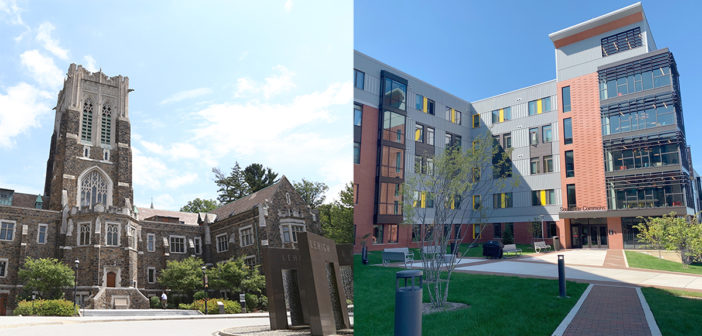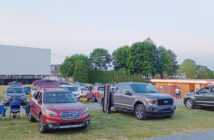Lehigh Facilities are working to expand the beauty of campus, while maintaining the iconic architecture of the historic buildings.
New buildings have been completed within the past year, including SouthSide Commons and the renovation of Chandler-Ullmann. Within the next few years, the College of Business expansion and the College of Health building will both be completed. The first phase of the new residential housing — Singleton, Hitch and Maida — will be finished this fall, with the second phase — the demolition of current Trembley Park houses, to be completed in 2022 or later.
Katelyn McNamara, ‘22, is studying architecture and said she is interested in the construction of the new buildings. She said one of the reasons she chose to attend Lehigh was because of the iconic buildings.
“I do feel like the old buildings mean more to Lehigh’s campus than the new ones,” McNamara said. “The ones that stand out are the University Center and Packard Lab, since they are historic and add to the university’s character.”
Although there are a mix of opinions on the design of some of these new buildings, University Architect Brent Stringfellow said he believes he is meeting the university’s future vision.
He said Lehigh doesn’t have a particular style to their buildings, and the evolution will be a representation of modern architecture. He said schools like Dickinson College and the University of Virginia have a clear style, and that Lehigh has a lot of great buildings that vary in different types of gothic styles.
“We look into trying to balance the legacy of Lehigh’s rich architecture, with buildings that are of their time and functioning to best fulfill the goals of the university,” Stringfellow said.
The styles at Lehigh have typified their era of when they were constructed and can understand when the buildings were built by looking at the outside design, Stringfellow said.
Chandler-Ullmann recently finished its renovation, but parts of the interior have remained unchanged since it was built in 1884. The windows and canopies at the entry were renovated, and new classrooms and offices that “reflect the needs of a contemporary academic building” were created, Stringfellow said.
He said Lehigh Facilities are investing money into the construction and renovation of these new buildings, and are looking at these buildings as a way to organize campus.
The University Center, which many consider to be the heart of campus, will be undergoing a significant renovation, but many of the old aspects of the building won’t be changed or restored. The historic parts of the building will be renovated, but will provide new spaces that are more modern, which will support student life, Stringfellow said.
McNamara said she doesn’t want to see the old buildings change, particularly the University Center, since she believes most people at Lehigh appreciate it for what it looks like now.
Ben Diflo, ‘22, is also in the architecture program and said the differences in architecture between the old and new buildings affects how he lives his life on campus.
“I like that a lot of the buildings have been more modern, like SouthSide Commons and Building C at Mountaintop,” Diflo said. “It feels like there are more open spaces, there’s bigger windows, the overall design is more sleek, and there’s not as much ornamentation. I think it separates the old buildings and new buildings, which I think is pretty cool.”
Stringfellow said he hopes these new buildings will form more “coherence” and “connectivity” on and off campus, and that they will bring a positive contribution to the rest of campus for years to come.
“It’s hard to have a building that everyone will entirely love and admire,” Stringfellow said. “Every time we construct new buildings, there’s always going to be varying opinions about the architecture of the building. Everyone will have their own personal opinions, but I think overall, the new buildings will have a positive impact on the rest of campus.”






Comment policy
Comments posted to The Brown and White website are reviewed by a moderator before being approved. Incendiary speech or harassing language, including comments targeted at individuals, may be deemed unacceptable and not published. Spam and other soliciting will also be declined.
The Brown and White also reserves the right to not publish entirely anonymous comments.
13 Comments
The claim by Vice President and University Architect Brent Stringfellow that Lehigh does not have a particular style to its campus is not wholly accurate. Nearly all campuses include some variability, as does Lehigh’s, yet the prime and lead style here has been the standard collegiate Gothic. At the heart of the campus there are four buildings of this type: the Alumni Mem. Bld, Packer Hall/the U.C., Linderman Library, and Packard Lab. The U.C. is a little different, but is so close to collegiate Gothic that I believe it should be included.
There are other buildings of this type, and it is also a question of how far up the campus you want to go. Grace Hall I would include, as well as the notable residence hall triad of Richards, Dravo and Drinker. There is also M & M dorm as well as Johnson Hall, which was a small jewel when initially built. Adding all we arrive at 10 buildings at or near the heart of the campus.
The problem of substantially altering the size and appearance of one, such as the University Center, could consequently hurt the standing of the others. Our student facilities, common rooms, lounges, etc. – our union if you would – does need expanding so as to fit a growing university in the 21st century. Yet should this be done by architecturally reinterpreting our foundational building?
Diflo said. “It feels like there are more open spaces, there’s bigger windows, the overall design is more sleek, and there’s not as much ornamentation. I think it separates the old buildings and new buildings, which I think is pretty cool.” The old buildings got stone, both walls and roofs. It would be interesting to see how much it would cost today to build such structures and also to see if artisans exist to do the work.
“It’s hard to have a building that everyone will entirely love and admire,” Stringfellow said. “Every time we construct new buildings, there’s always going to be varying opinions about the architecture of the building. Everyone will have their own personal opinions, but I think overall, the new buildings will have a positive impact on the rest of campus.” I don’t think the new buildings blend well with the old buildings. They can be “interesting” on the outside and exiting as well as utilitarian and efficient on the inside but they do tend to clash with the old which thankfully are mostly grouped together and screened by trees and separated by streets.
Mr. Davenport makes an apt comment: “[The newer buildings] can be ‘interesting’ on the outside, and exciting[,] utilitarian and efficient on the inside, but they do tend to clash with the old, which thankfully are mostly grouped together.” True, on Lehigh’s campus, the older buildings tend to be grouped together and separated from the newer ones. (As well as the converse of this.) When newer structures are placed next to the old, they are often are designed with similar architecture, such as Grace, Johnson Hall (the Health center), the M&M dormitory, and the 1958 extension to Packer Hall. And it all worked, making Lehigh’s campus one of the prettiest in America.
Now, after 100 years, some of Lehigh’s executives and administrators, such as Mr. Stringfellow and President Simon, want to change this. They even want to completely wreck the beautifully made 1958 stone extension.. Our older buildings were put up with patience and foresight, and debt was sometimes incurred that carried on for years.
However, I would like to point out that on one other related point Mr. Stringfellow is again not completely accurate. He has said that Lehigh does not have a “particular style” to its buildings, and I have argued one might consider it does: collegiate gothic. But an important component to this ‘style’ that Lehigh possesses, or has possessed, is the use of stone: a common though attractive igneous rock with grey and orange mottling. As opposed to my gothic point, this certainly is a very common architectural element around campus and besides from appearing in the ten buildings I have listed above it appears in others as well: Packer Church, Chandler-Ullmann, the Physics building, Drown, and many more. When not used in the construction of the broad body of modern structures, the use of stone will nevertheless often be used in exterior foundations or in adjacent complimentary structures, for example, note the Centennial complexes on the eastern end as well as the 1960s northern expansion of the campus into town where the Steps and Fairchild-Martindale buildings are.
Please therefore do not let Mr. Stringfellow’s one sentence pronouncement on Lehigh’s style, or lack of one, necessarily effect your perception of truth and the aesthetics of our campus. These are conclusions that should be reached via careful and sympathetic thought and not through one-line sloganizing. I believe the proposals of the administrators in regard to the reinterpretation of the University Center should, with all respect, be stopped, and largely for the reasons listed here.
“When not used in the construction of the broad body of modern structures, the use of stone will nevertheless often be used in exterior foundations or in adjacent complimentary structures, for example, note the Centennial complexes…” I checked my 50th reunion pictures and indeed saw stone foundations and retaining walls on my former campus home Congdon House. My pictures also show a stone background for the 9-11 memorial plaque dedicated 9-11-2006 as well as stone pedestals for the memorial benches outside of the Alumni Memorial. These are subtle reminders of the style, once bluntly obvious, that says Lehigh to it’s alumni.
Mr. Davenport:
If you check the ‘rear’, or the north (being the town) side, of the large 1960s expansion project into town across Packer Ave., where Maginnes, the Mart libraries, Sinclair and Whitaker laboratories are, & etc., below grade, which is the first story on the south side, stone is used, as in the Centennial complexes. (…) I resided two years early on during my Lehigh education in the Centennials, including the entirety of my freshman year, and had noticed Lehigh had done this, employing stone in this manner as a motif, and always thought it was a rather neat idea.
Another reason to consider the above noted claim of Mr. Stringfellow’s (viz. “Lehigh does not have a particular style to their buildings”) as being inaccurate, is that this postulation may be interpreted as meaning there is nothing which serves to unify the campus aesthetically. I have previously suggested that since many of our buildings are collegiate gothic, one could consider this style as being a unifying element… However, even more so would be the use of stone itself: almost all of our older buildings are made with it. Asa Packer himself was insistent the foundational building for Lehigh be made of stone and not brick.
This first building of Mr. Packer’s, known originally as Packer Hall and then ‘the University Center’, is largely what is being considered here. If we follow the recommendations of the administrators with respect to this structure (which would be a renovation consisting of a partial demolition, widespread remodeling, and expansion), then not only would we be not be building with stone at the core of the old campus (where the older buildings primarily exist), as well as not building with collegiate gothic, we would also be disobeying the founder’s instructions with regard to his own building. Do we really want to do this?
I therefore submit there are two artistic elements unifying our campus: collegiate gothic and the use of stone.
The truth is that Lehigh wants to build quickly and cheaply.
Lehigh does have an architectural style, and that style is collegiate gothic. In fact, the school’s architectural manual stipulates that we build only in stone.
Yale has modern buildings in addition to its collegiate gothic collection. But Yale’s new dorms match the older, more traditional collegiate gothic ones. Why? Because those are the buildings students love and remember.
https://news.yale.edu/2017/08/23/first-students-be-welcomed-two-new-residential-colleges-week
Other schools have recently unveiled their new dorms:
Colgate
https://haynerhoyt.com/portfolio/residence-halls-at-colgate-university/
Villanova
https://www.google.com/amp/s/www.inquirer.com/education/villanova-university-campus-dorms-crosses-development-20190817.html%3foutputType=amp
F&M
https://www.ramsa.com/projects/project/new-college-house
Compare these to the hideous black boxes that Lehigh is building. Something is seriously amiss.
https://thebrownandwhite.com/2020/04/18/lehigh-fall-housing-lottery-delay-causes-uncertainty/
The defacement of the UC is something I hope we can prevent with enough alumni support. Thoughts, Mr. Lewis?
Q.R.:
I replied below.
— J. Lewis
“I therefore submit there are two artistic elements unifying our campus: collegiate gothic and the use of stone.” I think this is undeniably true. The only question is how many other structures overall or in particular locations does it take to invalidate this truth? Seems as though the administration is attempting to find a definite answer to that question.
Will no one mourn the demise of the Trembley Park houses ://thebrownandwhite.com/2018/10/31/trembley-park-will-remain-open-for-upperclassmen-through-2020/ , I think not, the trees yes.
RFD:
Yes, (lol.) … However, in the elimination of Trembley Park, and if the administrators go ahead with the proposed ‘re-envisioning’ of the University Center, could Lehigh in effect be creating an even greater ‘Trembley Park’ …?
I agree with your comments, Q. R. Nonetheless, I understand the administrators proclivity to introduce lighter, brighter, and more airy spaces that appeals to the modern student. However, this can be taken too far. This is the case with the present proposed U.C. renovations: a striving for modernity at the expense of the past as well as an inordinate desire to get matters accomplished swiftly. Seeing that Packer Hall is our founding structure, and lies at the heart of the campus, a re-envisioning of the type and magnitude being considered will be a reinterpretation of Lehigh itself. This therefore could be a very serious mistake.
The “path to prominence” slogan, a worthy idea, is not new: it existed in the 1980s, if not prior. Transforming Lehigh into a first tier research school will be a difficult project, to be undertaken with as much an eye to the past as the future. As we are one of the oldest technical institutes in America, we have a history we can be proud of and in different ways. But what will be thought of us if we completely rework our founding structure using modern architecture instead of collegiate gothic, brick and glass instead of stone, as well as involving axis alteration and the elimination of the Asa Packer Dinning Room complex? A past this notable is not something to eliminate, it is something to build on. Our gothic heritage, dedication to the use of stone, and of when designing and constructing doing a fine job or none at all, all of this will be out the window.
What options can we pursue? Some enlargement of our Union facilities is needed, true enough. I propose five alternatives:
1. The wrecking of Drown, and the construction of a contiguous, collegiate gothic, southeastern extension to the U.C. (In addition to possibly other extensions.)
2. The construction of a non-contiguous, perhaps modern, ancillary union structure at the northeastern corner of Trembley. (One key point making the present, proposed, U.C. reinterpretation so problematical aesthetically is that it is physically contiguous with the old Packer Hall.)
3. The wrecking of the original Mart Library, with a modern union structure to be erected in its place.
4. A simple refurbishment of the U.C., without exterior alteration or a definite change in style, and a postponement of any great change or expansion until 2040.
5. A nationwide architectural competition for the redesign of the U.C., with prizes independent of commissions to be handed out.
My favorites in the above list are 4 and 5, yet I am open to any suggestion just so long as the present ‘re-envisioning’ can be prevented from going forward.
Some more comments for everyone. The core of our campus lies within the bounds of four roads: Packer Ave., Taylor St., University Dr., and Brodhead Ave. These are the boundaries, in addition to two key structures which help frame the area, as well as contributing style and atmosphere: the complementary structures of Taylor Gym and the Grace Hall. But as Lehigh commenced a very small school there are naturally some structures that have become antiquated with time, possibly even anachronistic, and the latter might include Drown Hall, Coxe, and Coppee. Buildings can be re-outfitted and have been, nonetheless, there are certain facets which are onerous if not impossible to overcome, such as supporting walls, interior divisions, stairwells, entrances and exits. Even some of our larger structures are affected by this issue, including the University Center itself. But as a general rule, the larger the structure the less this ‘antiquating factor’ will affect and limit it.
Notwithstanding all, it is these structures that many students come to expect and love in a university campus. We have been very good, by and large, throughout the years in building handsome structures and typically with stone. Some mistakes were made but they were not critical or unduly significant. Now in the 21st century executives and administrators, broadly, are beginning to realize this and so we see other schools such as Villanova attempting to out Lehigh Lehigh…! I have not been to that campus, but fine. Seeing then how much these (vintage) structures contribute to collegiate atmosphere, the U.C., Alumni Mem., Linderman, Packer Church, Packard Lab, & etc. should be treated deferentially as well as the area around them.
I was discussing these and related issues once with a professor of mine, and remember him saying (politely) Lehigh’s gothic is nothing like what they have in Europe. I understand this was a casual comment, but it is a ridiculous comparison: those are countries older than us by millennia. We have to build upon what we have.
As land is very valuable at the campus core, the question then becomes: what to do with the antiquated buildings? I suggest as a general rule to work with them, those considered noteworthy, and therefore maintain the collegiate gothic style inside of the boundaries. Expansions of certain buildings are going to be difficult, such as the U.C. and Linderman: difficult but possible. Some of the older structures may need to be taken down so as to provide space for our greater ones, just as in a forest a tree will grow and win out over others, while spreading its crown. And we should try, as much as possible in a changing situation, to come up with very long term goals and ideas.
However, and as proposed by the administrators, if we begin making over, re-interpreting, or re-envisioning our older structures with modern architectural forms and styles, brick and glass in place of stone, we are in effect saying the older buildings are nice, but we can do better… Can we…? We are already said to have one of the more attractive campuses in the east, and we want to change matters? These are weighty and problematical issues which is why I recommend proceeding cautiously. We have indeed waited, but perhaps we need to be patient a little longer. I therefore favor the conservative solutions outlined above to the specific problem of the student union.